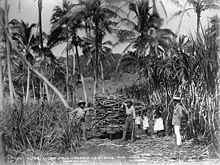

Alfred Henry Burton (c. 1834 – 2 February 1914) is a nineteenth-century New Zealand photographer.
Biography
Burton was born in Leicester, England. His father, John Burton, was a photographer and his firm was called John Burton and Sons. Burton and his three brothers also did photography. His brother Walter John Burton emigrated to New Zealand first and after being inundated with work requested Alfred join him, and in 1868 he did. The business was renamed Burton Brothers. Alfred Burton travelled in New Zealand taking landscape images for the business including Fiordland, the Southern Lakes and South Westland.
In 1877 the brother business partnership split up. Walter left for Europe and Alfred took over the firm. He employed other photographers such as George Moodie and Thomas Muir. A trip to the Pacific Islands in 1884 had Burton creating staged photographs of people and villages.
Significant photographs of Burtons were taken during 1885 to 1886 when he went to the King Country in the western North Island of New Zealand. With little contact of photography the Māori people in the photographs didn't pose and the 150 plates he took are now considered useful ethnographic portraiture.
After the destruction of the New Zealand tourist attraction the Pink and White Terraces in 1886 Burton took new photos, his 'before and after' shots were useful to researchers. Burton continued practicing with the Burton Brothers business in the 1880s but had stopped by 1889. The business continued and prospered from a demand for postcards in the early 1900s. Henry Burton the son of Burton who worked at the business as a photographer, was killed in a horse accident in 1901.
After his retirement from photography Burton invested is time in theatrical and other pursuits. He helped found the Dunedin Shakespeare Club, he started writing and there was an elocution school that his daughter Oona Burton worked at for a time.
Burton came ninth in the three-member City of Dunedin electorate in the 1896 election.
Burton died in 1914.
References
- "Derbyshire Photographers Profiles : John Burton & Sons of Derby". Roots Web. Archived from the original on 24 December 2020. Retrieved 28 January 2021.
- ^ "The Burton Brothers". Museum of New Zealand Te Papa Tongarewa. Archived from the original on 7 February 2012. Retrieved 11 February 2014.
- "Burton & Sons". Photographers 1840 – 1940 Great Britain & Ireland. Retrieved 28 January 2021.
- Hore, Jarrod (8 May 2019). "Capturing Terra Incognita: Alfred Burton, 'Maoridom' and Wilderness in the King Country". Australian Historical Studies. 50 (2): 188–211. doi:10.1080/1031461x.2019.1592205. hdl:1959.4/unsworks_81061. S2CID 164865494.
- Bunn, Rex; Nolden, Sascha (7 June 2017). "Forensic cartography with Hochstetter's 1859 Pink and White Terraces survey: Te Otukapuarangi and Te Tarata". Journal of the Royal Society of New Zealand. 48: 39–56. doi:10.1080/03036758.2017.1329748. ISSN 0303-6758. S2CID 134907436.
- Bunn and Nolden, Rex and Sascha (December 2016). "Te Tarata and Te Otukapuarangi: Reverse engineering Hochstetter's Lake Rotomahana Survey to map the Pink and White Terrace locations". Journal of New Zealand Studies. NS23: 37–53.
- Knight, Hardwicke (1993). "Burton, Alfred Henry". Te Ara – the Encyclopedia of New Zealand. Archived from the original on 11 February 2013. Retrieved 28 January 2021.
- "Otago". Auckland Star. Vol. XXVII, no. 305. 23 December 1896. p. 6. Retrieved 6 January 2014.
- "City of Dunedin Electoral District". Otago Daily Times. No. 10666. 4 December 1896. p. 1. Retrieved 11 February 2014.